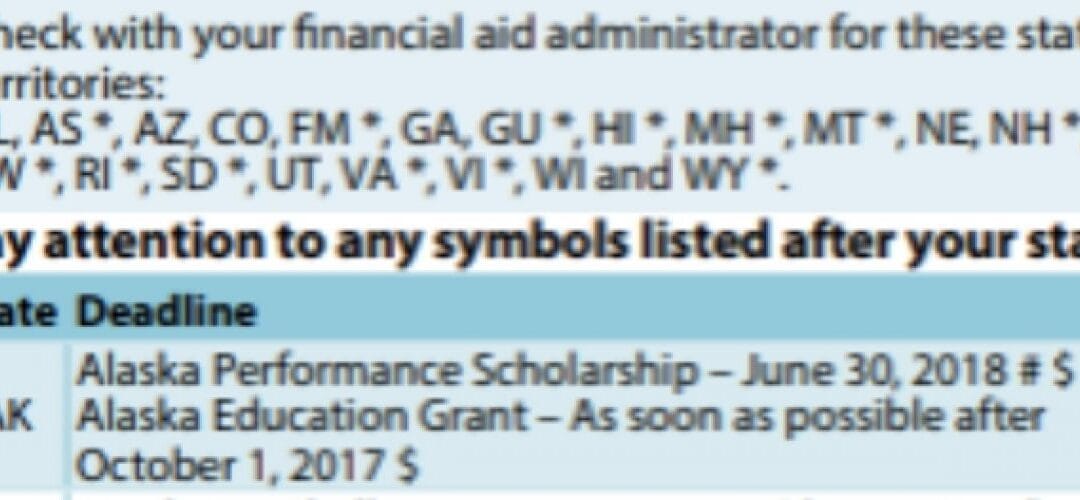By Paul Culp, MA (Oxon.), CFT, GCDF, CCSP
The process of researching and applying for financial aid can be confusing for many reasons, not least the number of aid mechanisms available, but while the ocean of college finance is indeed teeming with life—some of it friendlier than others—it isn’t quite as complex as it appears when you first dip your toe into it. The life forms can be grouped handily into four species:
Grants
Grants account for more than half of all financial aid nationwide. They are typically based on financial need and do not require repayment. The best-known example is the Pell Grant, which is administered by the U.S. Department of Education. Sources of other grants include federal and state governments, the colleges themselves, corporations, non-profits, activist and advocacy organizations, labor unions, and individual philanthropists, to name a few.
Some grants are applied directly to your bill, so you never see the money, just a lower bill or no bill at all. In other cases the funds are given to you outright, which allows you some choice regarding exactly how to spend it and which therefore requires some prudence on your part.
Scholarships
Scholarships are similar to grants in that they do not require repayment. They generally are not need-based, at least in theory, and are awarded on the basis of criteria determined by the colleges or other entities (see above, under grants) bestowing them. Benefactors offer partial and full scholarships in recognition of academic performance, athletic prowess, ethnicity, political interests, business ambitions, artistic talent, and community service, among other criteria. As with grants, in some cases the funds are applied to your bill and in others you receive money directly.
Loans
Loans are funds that you borrow and must repay, at interest. As we have noted elsewhere (An Arm and a Leg and Your First-born Child: Why College Costs so Much, September 6, 2018), student loan debt is now the second-largest consumer debt category, trailing only mortgage debt.
Loans from the federal government generally offer the lowest interest rates and take need into account instead of depending entirely on the student’s credit history. Private student loans on the other hand are offered by banks and other lending institutions to cover college costs that remain after other financial aid mechanisms have been applied, and the borrower’s credit history is the key element.
Work-study
Work-study awards are need-based and are administered by the federal government. They promote student employment by paying part of a student’s salary, usually for an on-campus job. The subsidy makes it easier for an employer to pay the student, who then supports himself or herself via that job.
Knowing the generalities of what’s out there, starting with the four basic types of financial aid, is one thing, but knowing how to identify particular financial aid packages and navigate the application process is something else. The Coaching Educator has devoted nearly a decade to helping students and their families identify all of their financial aid options and manage the application procedures successfully. To learn more about our philosophy and capabilities, be sure to watch our free webinars, listen to our podcasts, sign up for our four-week College App Boot Camp, consider our Ultimate Programs and our special services for athletes and performing-arts students, and book a consultation to hear what we can do for you and how we do it. Keep reading this blog, and look for us on social media (see links below) as we keep our clients and admirers advised of new developments in our effort to help students get into and succeed at the right school.
Paul Culp is certified as a global career development facilitator and writes about college admissions, college costs, financial aid, and college life in general for The Coaching Educator team. A former journalist and corporate ghostwriter who now operates Shenandoah Proofreading, Editing & Composition Services (SPECS), he has also been a humanities teacher at all levels from university down to sixth grade. Paul has degrees from Oxford University, Jacksonville State University, and Samford University, and also is certified as a fitness trainer.
Recommended Reading About College Admissions and Financial Aid
Culp, Paul. “An Arm and a Leg and Your First-born Child: Why College Costs So Much, The Coaching Educator, http://tce.local/2018/09/06/an-arm-and-a-leg-and-your-first-born-child-why-college-costs-so-much/
Culp, Paul. “Eat Your Alphabet Soup: FAFSA, EFC, COA, and Other Delights,” The Coaching Educator, http://tce.local/2018/11/06/eat-your-alphabet-soup-fafsa-efc-coa-and-other-delights/
Culp, Paul. “Not So Fast, Part 2: When Scholarships Get Taken Away,” The Coaching Educator, http://tce.local/2019/02/20/not-so-fast-part-ii-why-scholarships-get-taken-away/
Culp, Paul. “The Odds Are Good But the Goods Are Odd: 16 Unusual Scholarships,” The Coaching Educator, http://tce.local/2018/10/12/the-odds-are-good-but-the-goods-are-odd-16-unusual-scholarships/
Culp, Paul “Part 2: The Odds Are Good But the Goods Are Odd: 10 More Unusual Scholarships,” The Coaching Educator, http://tce.local/2019/03/20/part-2-the-odds-are-good-but-the-goods-are-odd-10-more-unusual-scholarships/
Culp, Paul. “Ten Common Mistakes You Must Avoid in Applying for Scholarships,” The Coaching Educator, http://tce.local/2019/02/06/ten-common-mistakes-you-must-avoid-in-applying-for-scholarships/

